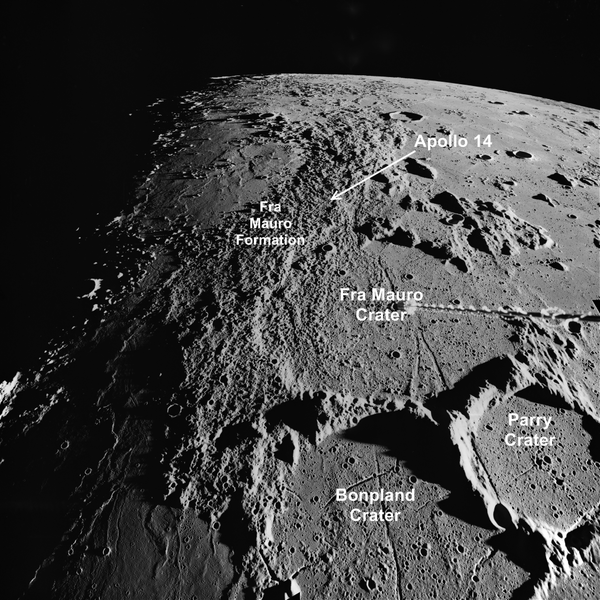
| Project Home | About the Scans | Browse Gallery | Image Map | Support Data | Resources | Ephemeris |
Featured Image - 04/07/2009
The Fra Mauro Formation
This stunning oblique Apollo Metric photograph shows the Apollo 14 landing site explored by Alan Shepard and Edgar Mitchell in January 1971 as viewed from the Apollo 16 Command Service Module Casper in April 1972. The rough, craggy looking materials you can see in the center of the frame are the Fra Mauro formation, named after nearby Fra Mauro crater. The Fra Mauro formation is ejecta from the Imbrium basin-forming event, which is just over the horizon to the north .
Figure 1. Annotated Apollo 16 Metric Mapping
Camera frame showing the Fra Mauro formation south of the Imbrium
basin (Apollo Image AS16-M-1420 [NASA/JSC/Arizona State
University])
The Fra Mauro site was one of only two highlands sites to be visited during Project Apollo, and the samples collected at the Apollo 14 landing site continue to provide lunar scientists with important insights into the geology of the lunar highlands. Nearly all of the Apollo 14 samples are breccias (or rocks formed from pieces of other rocks, often held together by an impact-melt matrix). Breccias were also found later to be the primary rock type at the Apollo 16 landing site, and consequently are now known to be ubiquitous in the lunar highlands. Since the Fra Mauro formation is ejecta from the Imbrium basin-forming event, age-dating the samples returned by Shepard and Mitchell in terrestrial laboratories indicated that the Imbrium basin formed approximately 3.85 billion years ago, providing a crucial absolute age date for the formation of the Imbrium basin, a crucial event in the lunar geologic timescale.
Despite the momentous discoveries made by the Apollo 14 and Apollo 16 crews, there is still much we do not know about the lunar highlands. In particular, lunar scientists are eager to use the remote sensing data returned by the Lunar Reconnaissance Orbiter and other ongoing lunar missions like Kaguya and Chandrayaan-1 to look for evidence of highlands rock types which may be underrepresented in the current Apollo sample collection. Since we only explored two locations in the lunar highlands during Apollo, it is possible that there are lunar highlands rock types which have not yet been sampled. By identifying the location of any under-sampled rock types on the lunar surface using orbital data, the scientific results obtained by these new lunar scouts will help to determine the places on the Moon where we need to send future human explorers.
For more information:Apollo 14 Sample Overview at the Lunar and Planetary Institute
Apollo Over the Moon: A View From Orbit (1978) H. Masursky, G. W. Colton, F. El-Baz, eds. NASA SP-362. Wilhelms, Don E. (1987) The Geologic History of the Moon, U. S. Geological Survey Professional Paper 1348.
Tweet

|
|
Space Exploration Resources |
|
 LPI LPI
|
